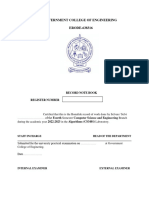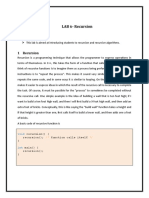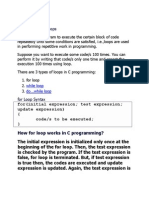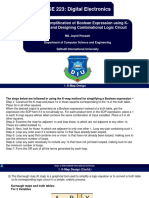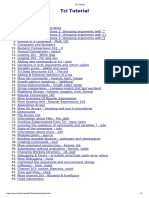Complete Note on Recursion
1. Introduction to Recursion
Recursion is a powerful programming technique where a function calls itself to solve a smaller instance of
the same problem. It is especially useful for problems that can be divided into similar subproblems, such as
mathematical computations, data structure manipulations (like trees), and certain algorithmic tasks (like
sorting and searching).
Key Components of a Recursive Function:
1. Base Case: This is the condition under which the recursion terminates. A base case is essential to
prevent infinite recursion, which can lead to a stack overflow error. The base case usually represents
the simplest instance of the problem, for which the solution is known.
2. Recursive Case: This is the part of the function where the function calls itself with a modified
argument that moves towards the base case. The recursive step divides the problem into smaller
instances and combines their solutions to solve the original problem.
2. How Recursion Works
Recursion works by breaking down a problem into smaller subproblems and solving each subproblem
recursively. Each recursive call adds a new frame to the call stack, which is the memory structure used to keep
track of active function calls. The stack grows with each recursive call and shrinks as each call returns its
result.
Key Points about Recursion:
Each recursive call has its own execution context, including its own variables and
parameters, which are stored in the call stack.
Recursive solutions can often be transformed into iterative solutions using loops
and stacks. However, recursion provides a natural and intuitive way to solve
problems that have a recursive structure, such as tree traversals or divide-and-
conquer algorithms.
3. Recursion in Different Programming Languages
Recursion is supported in almost all modern programming languages, including Python, Java, and C++. Each
language provides its own way of implementing recursive functions, with varying considerations for recursion
depth and memory usage.
3.1 Recursion in Python
Python supports recursion natively and provides an easy syntax to define recursive functions using the def
keyword. However, Python has a default recursion depth limit (typically set to 1000) to prevent infinite
recursion, which can cause a stack overflow.
import sys
print(sys.getrecursionlimit()) # Output: 1000
You can change this limit using sys.setrecursionlimit(), but this is generally not recommended unless
you have a good reason and understand the risks, as increasing the recursion limit can lead to crashes if not
handled properly.
Python Example: Factorial of a Number
The factorial of a number nnn is defined as n!=n×(n−1)×(n−2)×...×1n! = n \times (n-1) \times (n-2) \times ... \
times 1n!=n×(n−1)×(n−2)×...×1. The recursive definition of factorial is:
Base Case: n=0n = 0n=0 or n=1n = 1n=1, return 1.
Recursive Case: n×factorial(n−1)n \times \text{factorial}(n-1)n×factorial(n−1)
Python Implementation:
def factorial(n):
if n == 0 or n == 1: # Base case
return 1
else:
return n * factorial(n - 1) # Recursive case
# Example usage
print(factorial(5)) # Output: 120
Code Trace for factorial(5):
� 1. factorial(5) calls factorial(4)
2. factorial(4) calls factorial(3)
3. factorial(3) calls factorial(2)
4. factorial(2) calls factorial(1)
5. factorial(1) returns 1
6. factorial(2) returns 2 * 1 = 2
7. factorial(3) returns 3 * 2 = 6
8. factorial(4) returns 4 * 6 = 24
9. factorial(5) returns 5 * 24 = 120
3.2 Recursion in Java
Java supports recursion in a similar manner to Python, using the public or private access modifiers and the
static keyword for class-level methods.
Java Example: Factorial of a Number
public class RecursionExample {
public static int factorial(int n) {
if (n == 0 || n == 1) { // Base case
return 1;
} else {
return n * factorial(n - 1); // Recursive case
}
}
public static void main(String[] args) {
System.out.println(factorial(5)); // Output: 120
}
}
3.3 Recursion in C++
In C++, recursion is implemented using functions and requires careful management of stack memory,
especially for deep recursions.
C++ Example: Factorial of a Number
#include <iostream>
using namespace std;
int factorial(int n) {
if (n == 0 || n == 1) { // Base case
return 1;
} else {
return n * factorial(n - 1); // Recursive case
}
}
int main() {
cout << factorial(5) << endl; // Output: 120
return 0;
}
4. Other Common Examples of Recursion
Example 1: Fibonacci Sequence
The Fibonacci sequence is defined recursively as:
Base Cases: F(0)=0F(0) = 0F(0)=0, F(1)=1F(1) = 1F(1)=1
Recursive Case: F(n)=F(n−1)+F(n−2)F(n) = F(n-1) + F(n-
2)F(n)=F(n−1)+F(n−2) for n>1n > 1n>1
Python Implementation:
def fibonacci(n):
if n == 0: # Base case
return 0
elif n == 1: # Base case
return 1
else:
� return fibonacci(n - 1) + fibonacci(n - 2) # Recursive case
# Example usage
print(fibonacci(5)) # Output: 5
Java Implementation:
public class RecursionExample {
public static int fibonacci(int n) {
if (n == 0) { // Base case
return 0;
} else if (n == 1) { // Base case
return 1;
} else {
return fibonacci(n - 1) + fibonacci(n - 2); // Recursive case
}
}
public static void main(String[] args) {
System.out.println(fibonacci(5)); // Output: 5
}
}
C++ Implementation:
#include <iostream>
using namespace std;
int fibonacci(int n) {
if (n == 0) { // Base case
return 0;
} else if (n == 1) { // Base case
return 1;
} else {
return fibonacci(n - 1) + fibonacci(n - 2); // Recursive case
}
}
int main() {
cout << fibonacci(5) << endl; // Output: 5
return 0;
}
Example 2: Binary Search
Binary search is a divide-and-conquer algorithm for searching a sorted array by repeatedly dividing the
search interval in half.
Python Implementation:
def binary_search(arr, low, high, x):
if high >= low:
mid = (high + low) // 2
# Base case: Element is present at the middle
if arr[mid] == x:
return mid
# Element is smaller than mid, search left subarray
elif arr[mid] > x:
return binary_search(arr, low, mid - 1, x)
# Element is larger than mid, search right subarray
else:
return binary_search(arr, mid + 1, high, x)
else:
# Element is not present in array
return -1
# Example usage
arr = [2, 3, 4, 10, 40]
�x = 10
result = binary_search(arr, 0, len(arr)-1, x)
print(result) # Output: 3 (index of 10 in the array)
Java Implementation:
public class RecursionExample {
public static int binarySearch(int[] arr, int low, int high, int x) {
if (high >= low) {
int mid = low + (high - low) / 2;
// Base case: Element is present at the middle
if (arr[mid] == x) {
return mid;
}
// Element is smaller than mid, search left subarray
if (arr[mid] > x) {
return binarySearch(arr, low, mid - 1, x);
}
// Element is larger than mid, search right subarray
return binarySearch(arr, mid + 1, high, x);
}
// Element is not present in array
return -1;
}
public static void main(String[] args) {
int[] arr = {2, 3, 4, 10, 40};
int x = 10;
int result = binarySearch(arr, 0, arr.length - 1, x);
System.out.println(result); // Output: 3
}
}
C++ Implementation:
#include <iostream>
using namespace std;
int binarySearch(int arr[], int low, int high, int x) {
if (high >= low) {
int mid = low + (high - low) / 2;
// Base case: Element is present at the middle
if (arr[mid] == x) {
return mid;
}
// Element is smaller than mid, search left subarray
if (arr[mid] > x) {
return binarySearch(arr, low, mid - 1, x);
}
// Element is larger than mid, search right subarray
return binarySearch(arr, mid + 1, high, x);
}
// Element is not present in array
return -1;
}
int main() {
int arr[] = {2, 3, 4, 10, 40};
int x = 10;
� int result = binarySearch(arr, 0, 4, x);
cout << result << endl; // Output: 3
return 0;
}
5. Applications of Recursion
Recursion is a versatile tool in computer science, mathematics, and problem-solving. Here are some key
applications:
1. Divide and Conquer Algorithms: Algorithms like quicksort, mergesort, and binary search use
recursion to divide problems into smaller subproblems and solve them.
2. Tree and Graph Traversals: Recursive functions are ideal for traversing tree-like or graph structures
(e.g., depth-first search in graphs).
3. Dynamic Programming: Recursion is the basis for many dynamic programming techniques, where
overlapping subproblems are solved and stored for efficiency (e.g., memoization).
4. Backtracking Algorithms: Recursive backtracking is used in problems like solving mazes, the n-
queens problem, Sudoku, and generating permutations.
5. Mathematical Computations: Problems like calculating factorials, Fibonacci numbers, and
combinations are naturally expressed recursively.
6. Parsing and Expression Evaluation: Recursive descent parsers use recursive functions to process
input in compilers and interpreters.
7. File System Traversals: Recursive algorithms are used to traverse directories and files in file systems
(e.g., searching for files, calculating directory sizes).
8. Fractals and Graphics: Recursive functions generate fractals (e.g., Mandelbrot set, Sierpinski
triangle) and other graphics.
9. Game Theory and AI: Recursive algorithms, such as the Minimax algorithm, are used in AI for
decision-making and game playing.
10. Language Processing: Natural language processing and syntax trees often use recursion to parse
sentences and phrases.
6. Visualizing Recursion with Flowcharts
Flowcharts are helpful tools for visualizing recursive function calls and understanding the control flow. Here’s
how to create a flowchart for a recursive function:
1. Start: Draw a starting point.
2. Decision Box: Use decision boxes to represent the base case check.
3. Recursive Call: Draw arrows to indicate recursive calls branching from the
decision box.
4. Return Point: Indicate where the function returns a value and where recursive
calls return.
5. End: Mark the end of the function.
7. Advantages and Disadvantages of Recursion
Advantages:
Simplicity: Recursion often leads to simpler, more readable code for problems
that are naturally defined in terms of subproblems.
Code Reduction: It reduces the length of code by eliminating the need for
explicit stack management or iterative loops.
Disadvantages:
Memory Usage: Recursion can lead to high memory usage due to the stack of
function calls, especially if the recursion depth is large.
Performance: Recursive functions can be slower due to overhead from repeated
function calls and stack operations.
Depth Limitation: Most programming languages have a recursion depth limit,
which can be problematic for deep recursions without tail call optimization.
�Applications of Recursion in Networking
Recursion is a powerful technique widely used in networking to solve problems that involve repetitive tasks,
hierarchical data, and scenarios where a solution to a problem depends on solutions to smaller instances of the
same problem. Here are some specific applications of recursion in networking:
1. Recursive DNS Query Resolution
Usage: One of the most common uses of recursion in networking is in the Domain Name System (DNS).
When a DNS resolver receives a request for a domain name that is not cached, it uses recursion to query
multiple DNS servers to resolve the domain name to its corresponding IP address.
How It Works: The DNS resolver starts by querying the root DNS server, which returns the address
of a Top-Level Domain (TLD) server (e.g., for ".com"). The resolver then queries the TLD server,
which returns the address of the authoritative DNS server for the domain. This process continues
recursively until the domain name is resolved or an error is returned.
Example: If you want to resolve www.example.com, the DNS resolver will first query the root server,
then the .com TLD server, and finally the authoritative server for example.com recursively until the IP
address of www.example.com is found.
2. Recursive Network Pathfinding Algorithms
Usage: Recursive algorithms are used in network pathfinding and routing to explore all possible paths from a
source to a destination. This is especially useful in network analysis and troubleshooting.
Depth-First Search (DFS): DFS is a recursive algorithm used to explore all possible paths in a
network graph to find a route from a source node to a destination node. The algorithm starts at the
source node and explores as far as possible along each branch before backtracking.
Breadth-First Search (BFS) with Recursion: While BFS is generally implemented iteratively,
recursion can still be used for BFS in small networks or for educational purposes to understand
pathfinding logic in network topologies.
Example: In a network graph where nodes represent routers and edges represent connections, DFS can
be used recursively to determine all possible routes between two routers to find the most efficient
route or detect loops and unreachable nodes.
3. Recursive Descent Parsing for Network Protocols
Usage: Recursive descent parsers are used in the development of network protocol parsers. These parsers
process and validate network packets according to the rules of the protocol.
How It Works: Recursive descent parsing involves breaking down the input into smaller parts and
recursively processing each part according to a set of production rules. This is useful in networking for
parsing protocol headers, extracting data, and ensuring protocol compliance.
Example: In implementing a parser for a protocol like HTTP, a recursive descent parser might first
parse the request line, then recursively parse headers and body sections. Each parsing step can be
implemented recursively to handle nested or hierarchical structures within the protocol data unit
(PDU).
4. Recursive Backtracking in Firewall Rules and Access Control
Usage: Recursive backtracking is used in firewalls and access control systems to evaluate complex sets of
rules and determine whether network traffic should be allowed or blocked.
� How It Works: Firewalls often have complex rule sets that need to be evaluated in a specific order.
Recursive backtracking allows the firewall to test each rule and backtrack if a rule does not match,
moving on to the next possible rule until a matching rule is found or all rules have been evaluated.
Example: A firewall rule set might involve checking multiple conditions, such as source IP,
destination IP, port numbers, and protocols. Recursive backtracking can be used to evaluate these
conditions in sequence and make a decision based on the first matching rule.
5. Network Configuration Management
Usage: Recursive algorithms are used in network management systems to propagate configuration changes or
updates across a network of devices.
How It Works: When a configuration change is made on a central network management server,
recursive algorithms can be used to push this change out to all relevant devices. If a device depends on
configurations from multiple sources, recursion helps resolve these dependencies in the correct order.
Example: Consider a scenario where a network administrator needs to update the routing table
configuration on multiple routers in a hierarchical network. A recursive algorithm can be used to
traverse the network topology, pushing updates to each router recursively while ensuring that each
device receives the correct configuration in the right order.
6. Recursive Packet Processing in Network Simulations
Usage: Recursive methods are often used in network simulations to model the behavior of network protocols
and devices, especially when dealing with layered protocol stacks.
How It Works: Network simulators use recursion to simulate the passing of packets through various
protocol layers. Each layer processes the packet and then passes it to the next layer until the packet
reaches its destination or an error condition is encountered.
Example: In a simulation of the TCP/IP stack, a recursive function could be used to model packet
processing as the packet moves through the layers from the physical layer to the application layer,
recursively calling each layer’s processing function.
7. Hierarchical Network Models and Recursive Resource Allocation
Usage: Recursive algorithms are used in hierarchical network models to allocate resources efficiently across
different layers or sections of the network.
How It Works: In hierarchical networks, resources such as bandwidth, IP addresses, or virtual circuits
are allocated recursively from a central authority down to individual network segments or devices.
This recursive allocation ensures that resources are distributed according to network policies and
constraints.
Example: In a multi-layer virtual network, a recursive algorithm can be used to allocate virtual
circuits from a central pool to each layer of the network, ensuring that each layer has sufficient
resources while optimizing overall network performance.
8. Recursive Algorithms for Network Topology Discovery
Usage: Recursive algorithms are used in network discovery tools to map out network topologies, identify
devices, and determine the connections between them.
� How It Works: Recursive discovery algorithms start from a known point in the network and
recursively query adjacent devices to build a complete map of the network. This method is particularly
useful in large and complex networks where manual discovery would be impractical.
Example: In a network management system, a recursive algorithm might start at a known router or
switch and query all connected devices, then recursively query each discovered device to continue
building the network map.
9. Recursive Load Balancing in Content Delivery Networks (CDNs)
Usage: Recursive algorithms are used in content delivery networks (CDNs) for load balancing to distribute
network traffic efficiently across multiple servers and locations.
How It Works: Recursive load balancing involves distributing client requests to the nearest or least-
loaded server and recursively adjusting the distribution as network conditions change, such as server
availability or network congestion.
Example: A CDN may use recursive load balancing to ensure that a user’s request for content is
routed to the nearest available server, checking recursively against multiple criteria like server health,
load, and network latency.
10. Recursive Algorithms for Data Compression and Decompression
Usage: Recursive algorithms are used in networking for data compression and decompression techniques,
such as in the transmission of compressed data over a network.
How It Works: Recursive compression algorithms work by breaking data into smaller parts,
compressing each part recursively, and then combining the compressed parts into a final compressed
data stream. Decompression works in reverse by recursively decompressing each part until the original
data is fully restored.
Example: Recursive Huffman coding is a common compression technique that can be applied to
network data to reduce bandwidth usage. Recursive decompression algorithms are then used on the
receiving end to restore the data to its original form.
Recursion plays a vital role in networking, providing efficient and elegant solutions for complex tasks such as
DNS resolution, network pathfinding, protocol parsing, firewall rule evaluation, network configuration
management, and more. By breaking down problems into smaller, more manageable subproblems, recursive
algorithms enable network engineers and developers to implement robust and scalable network solutions that
can handle a wide range of tasks, from protocol processing to resource allocation and traffic management.
Understanding the applications of recursion in networking is essential for building efficient, reliable, and
high-performing network systems.
8. Conclusion
Recursion is a fundamental concept in computer science and mathematics, providing a powerful tool for
solving complex problems with elegant solutions. Understanding how recursion works, its applications, and
its limitations is essential for effective programming and problem-solving. Recursion offers a natural way to
express solutions for problems with recursive structures, making it a valuable technique for both beginners
and experienced developers.











